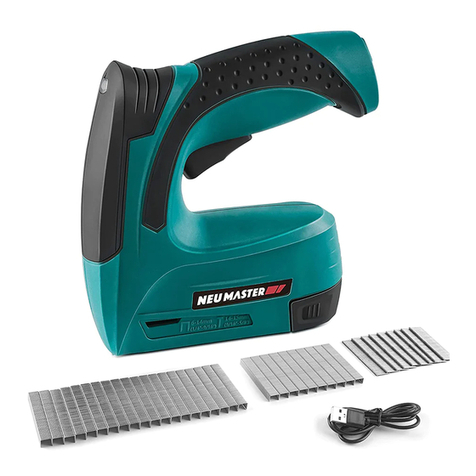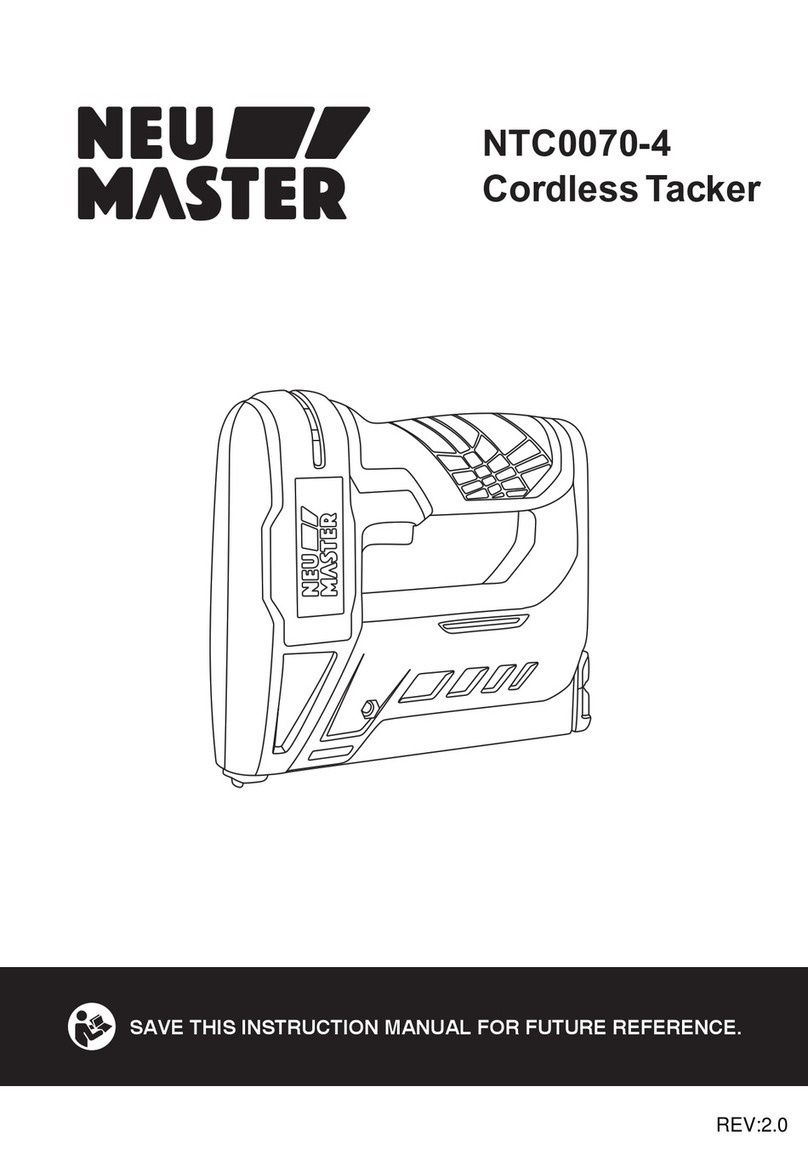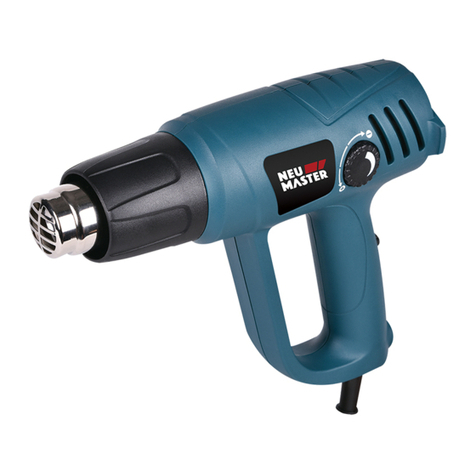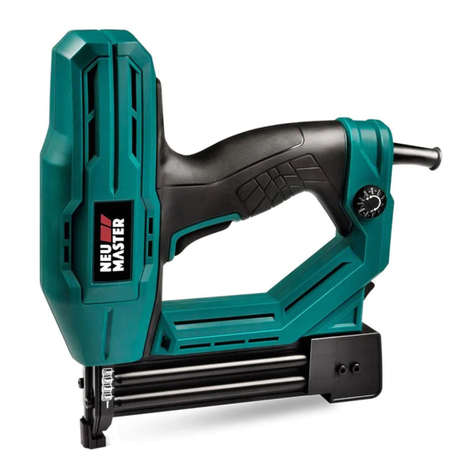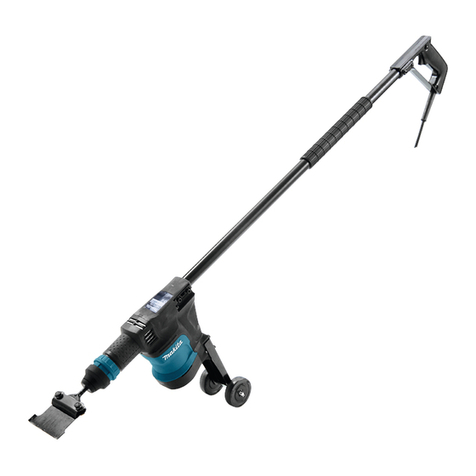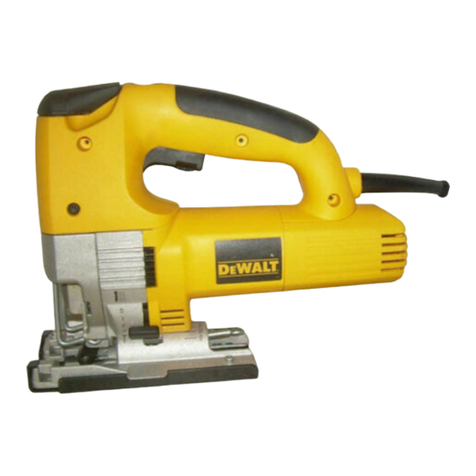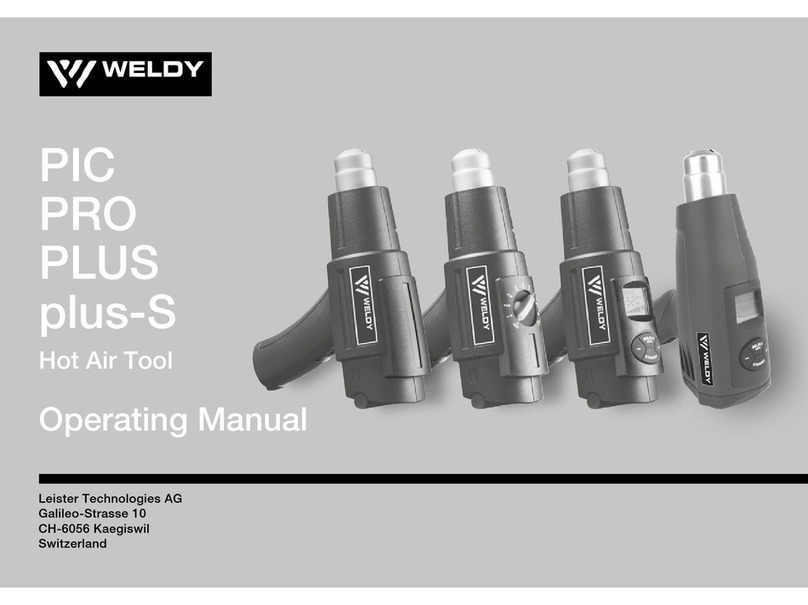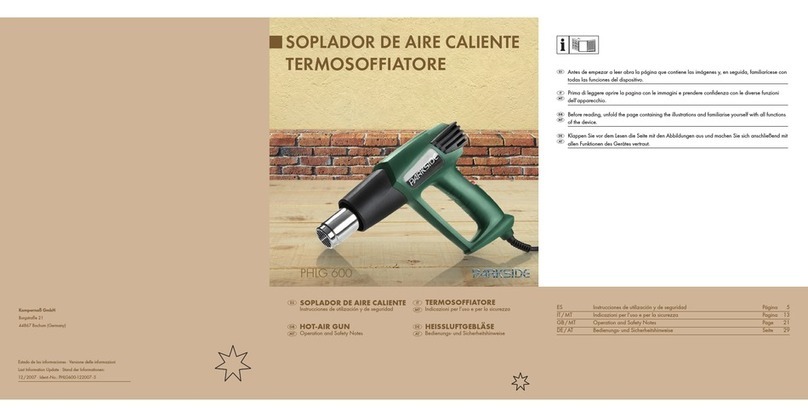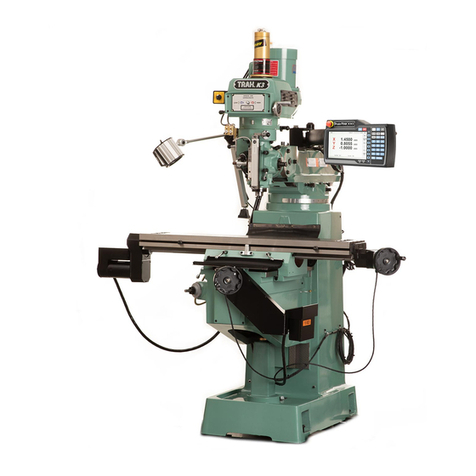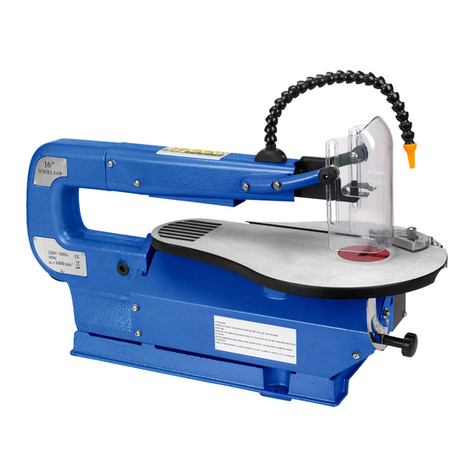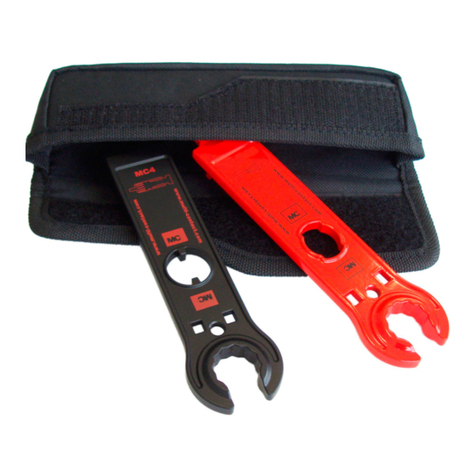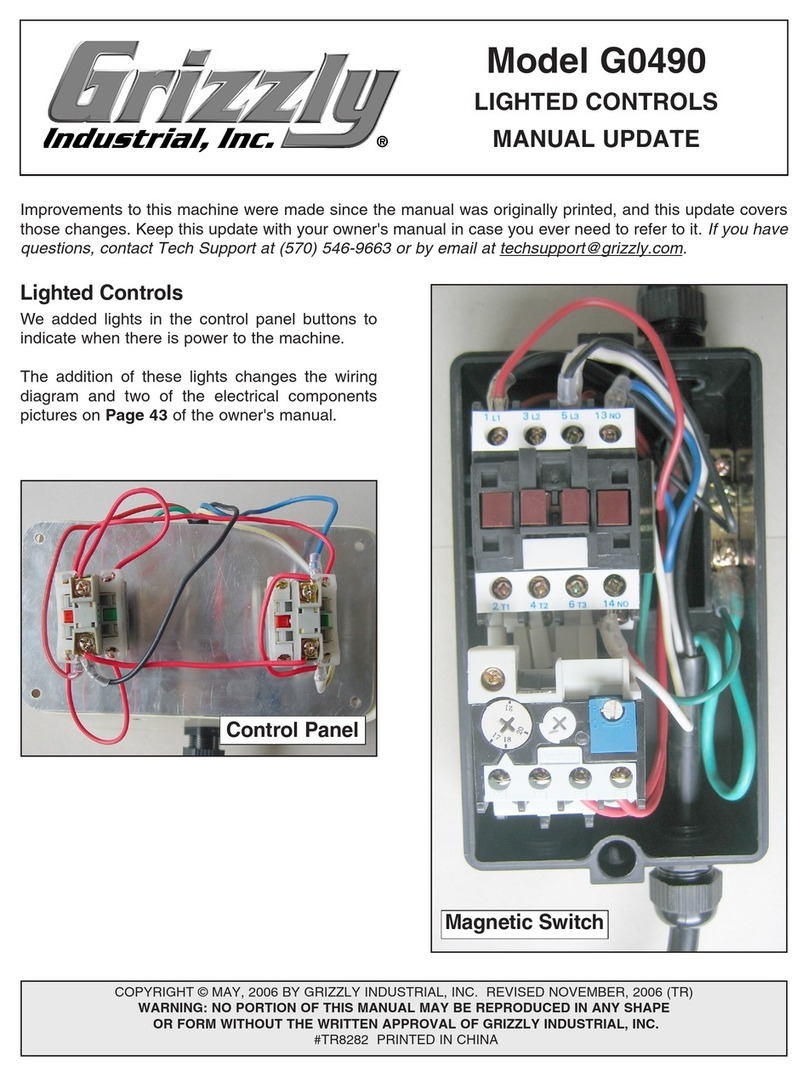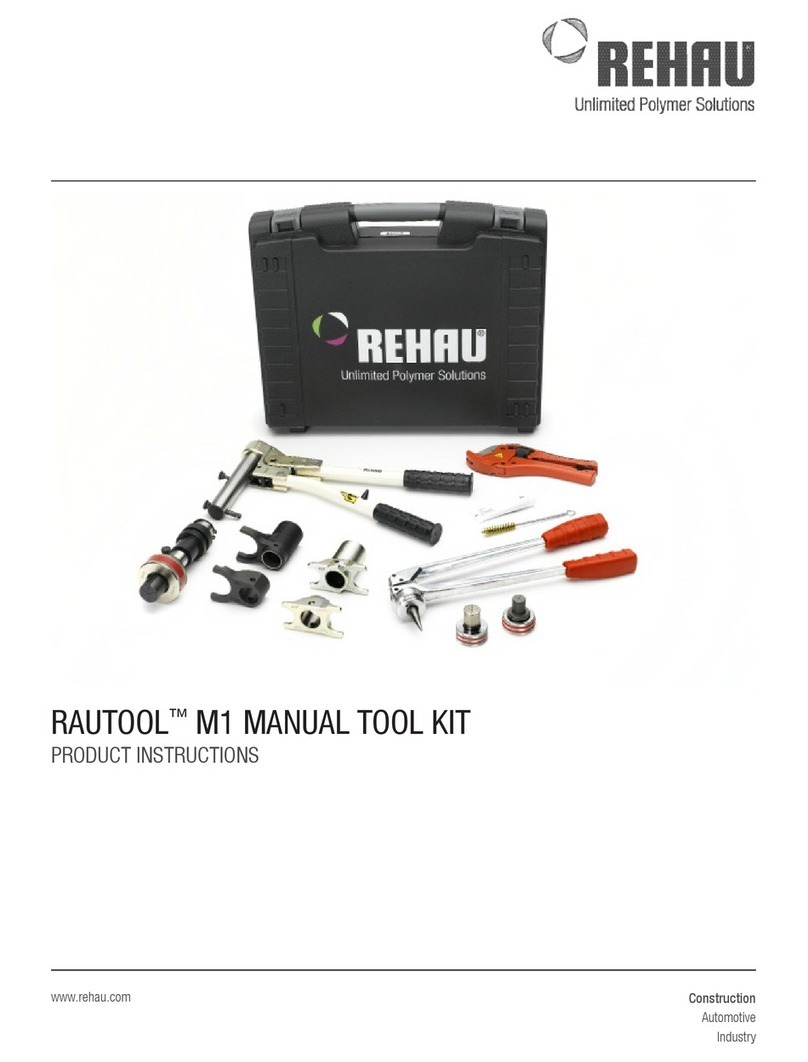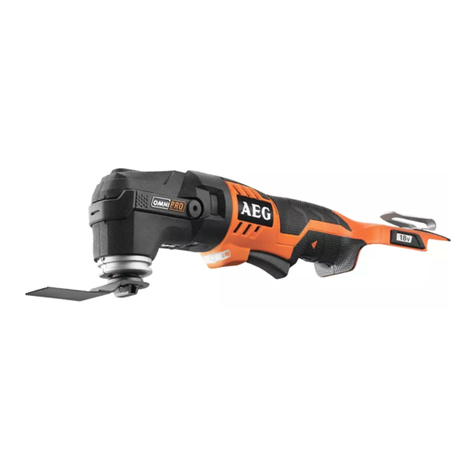NEU MASTER NTC0023-18 User manual

NTC0023-18
SAVE THIS INSTRUCTION MANUAL FOR FUTURE REFERENCE.
Cordless Tacker

01
Please read all instructions carefully before use and retain for future reference.
WARNING!
Some dust created by construction activities contains chemicals known to cause cancer, birth defects or
other reproductive harm.
Some examples of these chemicals are:
• Lead from lead-based paints
• Arsenic and chromium from chemically-treated lumber
Your risk from these exposures varies, depending on how often you do this type of work. To reduce your
exposure to these chemicals, work in a wellventilated
area and always use approved safety equipment such as dust masks that are specially designed to lter
out microscopic particles.
CAUTION Do not immerse in water.
Wear a dust mask
Protect your eyes.
Protect your ears.
Protect your hands.

1. Contact safety
2. LED Light
3. Impact Control Adjustment Knob
4. Trigger
5. Handle
6. Magazine Release Clip
7. Magazine
8. No-marring nose tip
9. Battery Release Button
10. Battery Power Display Button
11. Battery Indicator LEDs
12. Charger Pins
13. Light(Red)
14. Light (Green)
15. Staple
16. Nail
3
8
1
2
7
12
13 14
16
15
6
5
4
9
10
11
02

STAPLE NAIL
CHARGING
14
15
10
03
L=15-25 mm
Charging:
Red light, ashing green light
Flashing red light
Long green light
Both red and green lights are ashing
L=15, 20, 25, 30, 32 mm
BATTERY
crown gauge
Problem pack or Charger:
Gharger:
Hot/Cold delay:

04
Battery pack installation and removal
STAPLE
2
1
6
2
1
3

05
NAIL
32m
m
25mm
20mm
15mm

06
OPERATION
4
8
8
8

3
07
OPERATION

8
1
08
CLEARING A JAM

INTENDED USE Only operate the power tool/machine for its
manual.
This power tool/machine is for domestic use only. Do not use
outdoors or on wet surfaces.
This power tool/machine is not intended for use by persons
with reduced physical, sensory or mental capabilities, or lack
of experience and knowledge, unless supervised or given ap-
propriate instruction concerning the product’s use by a per-
son responsible for their safety.
GENERAL PRECAUTION Do not allow to be used as a toy.
Children should be supervised to ensure they do not play with
the power tool/machine.
If the power tool/machine is not functioning properly, has
been dropped, damaged, left outdoors, or immersed in liquid,
do not use, contact DOMU Brands Customer Services.
Do not use the power tool/machine if any parts appear to be
faulty, missing or damaged.
Ensure all parts are securely attached before use.
RISK OF PERSONAL INJURY Avoid body contact with
earthed or grounded surfaces such as pipes,radiators, ranges
and refrigerators. There is an increased risk of electric shock
if your
body is earthed or grounded.
position before connecting to the power source and/ or bat-
tery pack, picking up or carrying the tool. Carrying power tools
are switched on, invites accidents.
Do not operate power tools in explosive atmospheres such
tools create sparks which may ignite the dust or fumes.
Always wear eye protection. Any power tool can throw foreign
objects into your eyes and cause permanent eye damage. Al-
ways wear safety goggles (not glasses) that comply with ANSI
safety standard Z87.1. Every day glasses have only impact
resistant lenses.
Do not expose power tools to rain or wet conditions. Wa-
ter entering the power tools will increase the risk of electric
shock.
Stay alert, watch what you are doing and use common sense
when operating a power tool/machine. Do not use a power
drugs, alcohol or medication. A moment of inattention while
operating power tool/machine may result in serious personal
injury.
Use personal protective equipment. Always wear eye pro-
tection. Protective equipment such as dust mask, non-skid
safety shoes, hard hat, or hearing
protection used for appropriate conditions will reduce person-
al injuries.
Prevent unintentional starting. Ensure the switch is in the
pack, picking up or carrying the tool.
energizing power tool/machine that have the switch on invites
accidents.
Remove any adjusting key or spanner before turning the
power tool/machine on. A spanner or a key left attached to
a rotating part of the power tool/machine may result in per-
sonal injury.
Do not overreach. Keep proper footing and balance at all
times. This enables better control of the power tool/machine
in unexpected situations.
Dress appropriately. Do not wear loose clothing or jewellery.
Keep your hair, clothing and gloves away from moving parts.
Loose clothes, jewellery or long hair can be caught in moving
parts.
If devices are provided for the connection of dust extraction
and collection facilities, ensure these are connected and
properly used. Use of dust collection can reduce dust-related
hazards.
WORK AREA SAFETY Keep work area clean and well lit.
Cluttered or dark areas invite accidents.
Do not operate power tool/machine in explosive atmospheres,
Power tool/machine create sparks which may ignite the dust
or fumes.
Keep children and bystanders away while operating a power
tool/machine. Distractions can cause you to lose control.
GENERAL POWER TOOL USE AND CARE Do not force the
power tool/machine. Use the correct power tool/machine for
your application. The correct power tool/machine will do the
job better and safer at the rate for which it was designed.
Do not use the power tool/machine if the switch does not turn
-
trolled with the switch is dangerous and must be repaired.
Disconnect the plug from the power source and/or the battery
pack from the power tool/machine before making any adjust-
ments, changing accessories, or storing power tool/machine
tools. Such preventive safety measures reduce the risk of
starting the power tool/machine accidentally.
Store idle power tool/machine out of the reach of children and
do not allow persons unfamiliar with the power tool/machine
or these instructions to operate the power tool/machine.
Power tool/machines are dangerous in the hands of untrained
users.
Maintain power tool/machines. Check for misalignment or
binding of moving parts, breakage of parts and any other con-
damaged, have the power tool/machines repaired before use.
Many accidents are caused by poorly maintained power tool/
machines.
Keep cutting tools sharp and clean.
Properly maintained cutting tools with sharp cutting edges are
less likely to bind and are easier to control.
Use the power tool/machine accessories and tool bits in ac-
cordance with these instructions, take into account the work-
ing conditions and the work to be performed.
those intended could result in a hazardous situation.
CLEANING & MAINTENANCE Never soak or immerse elec-
trical components and or a component that has a plug at-
tached.
Disconnect the plug from the power source before making any
adjustments, changing accessories, or storing. Such preven-
tive safety measures reduce the risk of starting the power tool
accidentally.
Ensure the motor has fully stopped before cleaning, clearing
a blockage, checking, or carrying out any maintenance on the
tool.
Maintain your power tool. Check for misalignment or binding
of moving parts, breakage of parts and any other condition
use. Many accidents are caused by poorly maintained power
tools.
Keep cutting tools sharp and clean. Properly maintained cut-
ting tools with sharp cutting edges are less likely to bind and
are easier to control.
caused by normal use has not begun to loosen them.
Store idle power tools out of reach of children and do not al-
low persons unfamiliar with the power tool or these instruc-
tions to operate the Breaker.
Locate the power tool out of reach of children, in a dry, locked
unit.
Make sure that the cord is located so that it will not be stepped
on, tripped over, or otherwise subjected to damage or stress.
Remove the plug from the mains socket / battery (where ap-
plicable) before carrying out any adjustment or maintenance.
Always store the power tool/machine in a dry place.
09

-
-
If the power cord is damaged, it must be replaced by a quali
Keep the ventilation slots and motor housing as free of dirt
and dust as possible (where applicable).
Clean the power tool/machine by rubbing it with a clean cloth
and blow it clean using low-pressure compressed air is rec
ommended.
HAND HELD TACKERS
Secure the workpiece. Use clamps or a vice to hold the
workpiece as this is safer than using your hand and frees
both hands to operate the tool.
Do not use the power tool if the switch does not turn it on
switch is dangerous and must be repaired.
Do not force the power tool. Always use the correct power
tool for your application. The correct power tool will do the
job better and safer at the rate for which it was designed.
Do not overreach. Keep proper footing and balance at all
times. This will enable better control of the power tool in
unexpected situations.
Disconnect the plug from the power source and/or the bat-
tery and remove the nails/staples from the power tool before
making any adjustments, changing accessories or storing.
Such preventative safety measures reduce the risk of starting
the power tool accidentally.
Store idle power tools out of reach of children and do not
allow persons unfamiliar with the power tool or these instruc
tions to operate the tool. Power tools are dangerous in the
hands of untrained users.
Maintain the power tool. Check for misalignment or binding
of moving parts, breakage of parts and any other condition
repaired before use. Many accidents are caused by poorly
maintained power tools.
BATTERY WARNINGS (INCLUDING BUTTON CELLS, AA
BATTERYS, LITHIUM PACKS)
WARNING The use, and particularly abuse of portable
sealed secondary lithium cells and batteries may result in the
creation of hazards and may cause harm.
Do not dismantle, open or shred secondary cells or batteries.
Keep batteries out of the reach of children.
NOTE the battery pack is not fully charged out of the box.
Secondary cells and batteries need to be charged before
use, always refer to the cell or battery manufacturer’s
instructions and use the correct charging procedure.
manufacturer. A charger that is suitable for one type of
battery pack.
designated battery packs. Use of any other battery packs
First read the safety instructions and then follow the charging
notes and procedures.
Incorrect reassembly may result in a risk of electric shock
Protect the battery and charger against water and moisture.
Always keep cells and batteries clean and dry.
Wipe the cell or battery terminals with a clean dry cloth if
they become dirty.
a position away from any heat source and avoid storage in
direct sunlight.
Do not maintain secondary cells and batteries on charge
when not in use.
After extended periods of storage, it may be necessary to
charge and discharge the cells or batteries several times to
obtain maximum performance.
Do not short-circuit a cell or battery.
Do not store cells or batteries haphazardly in a box or drawer
where they may short-circuit each other or be short-circuited
by conductive materials. When the battery pack is not in
use, keep it away from other metal objects such as paper
clips, coins, keys, nails, screws or other small metal objects
that can make a connection from one terminal to another.
Short-circuiting the battery terminals together may result in
Do not expose cells or batteries to mechanical shock.
Never attempt to open the battery pack for any reason or
if the plastic housing of the battery pack breaks or cracks,
immediately discontinue use and do not recharge.
When possible, remove the battery from the appliance/power
tool/machine when not in use.
Do not leave a battery on prolonged charge when not in use
or stored for extended periods of time as this may cause
damage to the battery.
To facilitate cooling of the battery pack after use, avoid
placing the charger or battery pack in a warm environment
such as a metal shed or an uninsulated trailer.
To reduce the risk of electric shock, unplug the charger from
the outlet before attempting any cleaning. Removing the
battery pack will not reduce this risk.
In the event of a cell leaking, do not allow the liquid to come
into contact with the skin or eyes. If contact has been made,
seek medical advice.
Seek medical advice immediately if a cell or battery has been
swallowed.
Always observe the polarity marks (+) and (-) on the cell,
battery and equipment and ensure correct use.
Retain the original cell and battery literature for future
reference
When disposing of secondary cells or batterie, keep cells or
each other.
Do not use any cell or battery which is not designed for use
with the equipment.
or type within a device.
Always purchase the battery recommended by the device
manufacturer for the equipment.
ADDITIONAL SAFETY INFORMATION FOR BATTERY
CHARGERS.
This appliance should not be used by children and/
or persons with reduced physical, sensory or mental
capabilities or lack of experience and knowledge. Children
shall not play with the appliance.
Do not place any object on top of the charger or place the
charger on a soft surface that may result in excessive internal
heat.
Do not attempt to disassemble the charger. Take it to an
electrician or tool repairer when service or repair is required.
Appliances/power tools/machines with Lithium-ion batteries
ion battery charger purchased with this tool. Do not attempt
to charge the battery with any charger other than the one
supplied as this is potentially dangerous.
Before using the charger, read all instructions, labels and
cautionary markings on the charger.
The charger is not intended to be used for any purpose other
than charging the battery pack for this tool. Any other use
use the charger on any other voltage or rating than those
stated on the rating plate.
Do not use the charger for any purpose other than that for
which it is intended.
Do not use the charger to charge any device other than the
appliance/power tool/machine it was sold with.
10

Do not use an extension cord unless absolutely necessary.
not be stepped on, tripped over or otherwise subjected
electric shock.
Never attempt to connect two chargers together.
Use the battery charger indoors only.
Make sure that the charger cable is positioned where it will
to damage or stress. Keep the cord away from operating
appliance/power tool/machine.
Do not operate the charger in a cabinet or other enclosure
unless ventilation is adequate.
Do not place any object onto the charger or allow any object
to rest on the charger.
Never place the appliance/power tool/machine or charger
near or over a heat source such as radiator or heater.
WARNING! Never charge your Lithium-ion battery below or
or permanent damage to the battery.
The most suitable temperatures to charge the battery are
between 20°C/68°F and 25°C/77°F.
WARNING! Do not allow water or any other liquid to come
into contact with the charger as this may result in electric
shock. Do not position the tool or battery charger near water.
Take care not to spill liquid of any kind on the tool or charger.
DANGER! Do not use the charger if it has been subjected to
a heavy knock, dropped, or otherwise damaged in any way.
Take the charger to an authorised service centre for it to be
checked and repaired.
Do not attempt to disassemble the charger by opening or
removing covers.
To reduce risk of damage to the electric plug and cord, pull
by the plug rather than the cord when disconnecting the
charger.
TECHNICAL SPECIFICATION
Rated Voltage: 18V 2.0Ah
Charger Input: 100-240VAC 50/60Hz 70W
Charger Output: 21VDC 2.4A
11
Table of contents
Other NEU MASTER Power Tools manuals
Popular Power Tools manuals by other brands
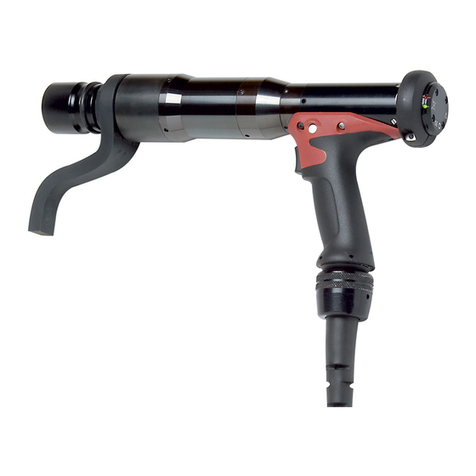
Desoutter
Desoutter Industrial Tools ECP Series manual

Sealey
Sealey GSA634.V2 quick start guide
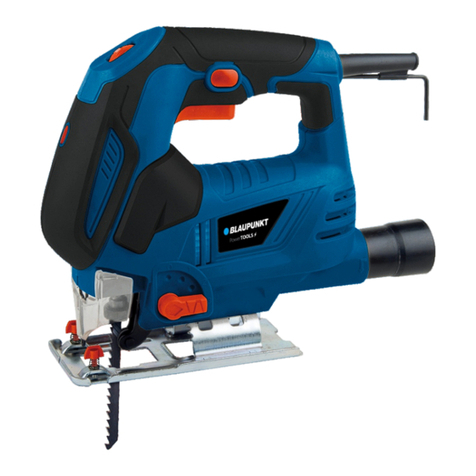
Blaupunkt
Blaupunkt JS5010 Original instruction manual
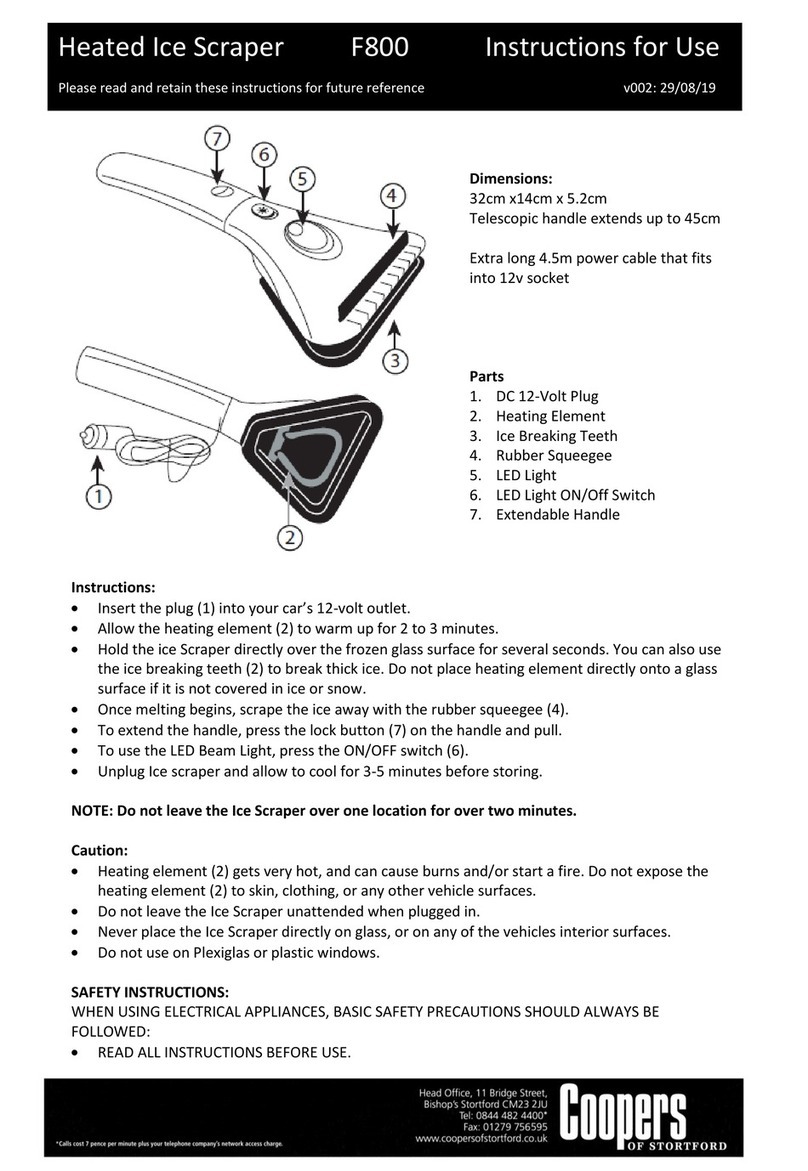
Coopers of Stortford
Coopers of Stortford F800 Instructions for use
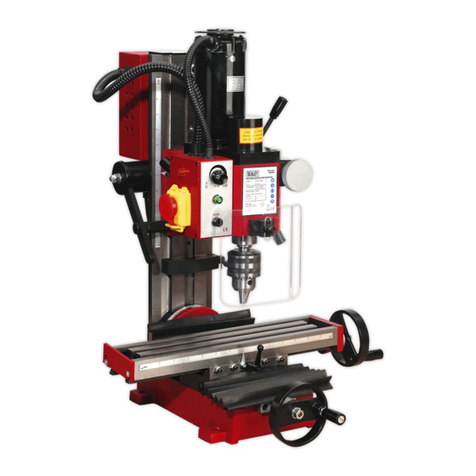
Sealey
Sealey SM2502 instructions
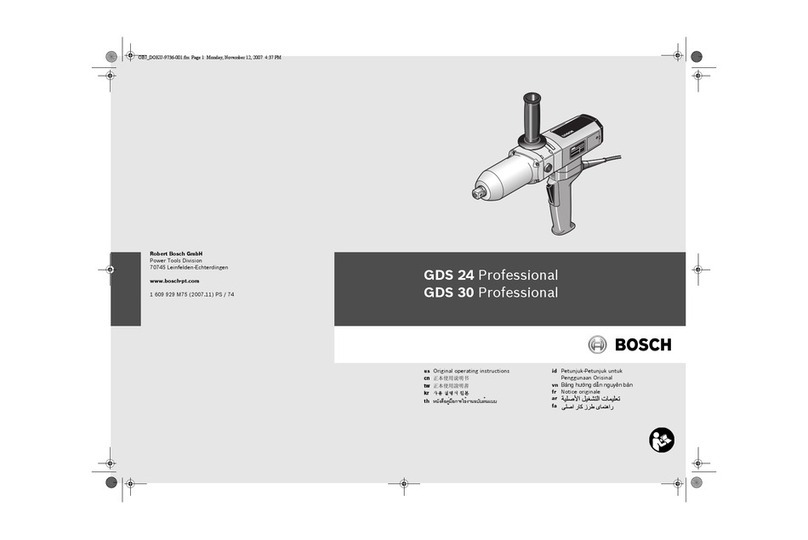
Bosch
Bosch GDS 24 Professional Original operating instructions

